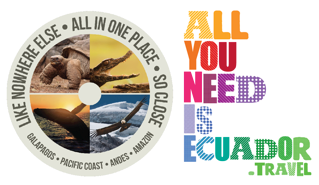The Republic of Ecuador is a representative democratic republic on the north west of South America. It is bordered by Colombia on the north, Peru on the east and south, and by the Pacific Ocean to the west. Ecuador straddles the equator, from which it takes its name, and has an area of 283,561 km2 / 109,415 sq ml. The country also includes the Galapagos Islands in the Pacific, about 1,000 kilometers (620 mi) west of the mainland.
Its Capital City and Seat of Government is Quito, which was declared a World Heritage Site by UNESCO in 1978 for having the best preserved and least altered historic center in Latin America.The country’s largest city and main port is Guayaquil. The historic center of Cuenca, the third largest city in the country, was also declared a World Heritage Site in 1999, for being an outstanding example of a planned inland Spanish style colonial city in the Americas.
Ecuador is home for more than 14 million people, hence it’s the ninth largest Spanish speaking nation in the world. The Spanish coexists with several indigenous languages recognized as co-officials in special jurisdictions of the country.
Its territory consists of four well-defined natural regions: Pacific Coast, Andes, Amazon and the Galapagos Islands. In the Ecuadorian Andes there are 70 volcanoes: 14 active, 14 inactive and 42 passive, being the highest the Chimborazo volcano with 6.310 m. It is also the country with the highest concentration of rivers per square kilometer in the world; they originate on the Andes and will flow to the Pacific through the Coast, and to the Atlantic through the Amazon Regions.
The Ecuadorian territory holds the densest biodiversity worldwide. There is a great variety of species, many of them endemic, like those of the Galapagos Islands. This species diversity makes Ecuador one of the seventeen mega-diverse countries in the world. The new constitution of 2008 is the first in the world to recognize legally enforceable Rights of Nature, or Ecosystem Rights.
Ecuador’s main export is Petroleum and is recognized worldwide as the main banana exporter and as one of the main exporters of shrimp, cut roses, cocoa beans and coffee beans amongst many other products.
It is a medium-income country with an HDI score of 0.806 (2010), and about 35.1% of the people living below the poverty line.
First peoples into Ecuadorian territory back to 11000 BC, which developed several pre-Columbian cultural phases covering up the first Inca invasions in the late 15th century, becoming part of Tawantinsuyu. The Spanish conquest in this territory began in 1534 and almost 300 years the European colony lasted. The independence period had its origins in 1809, and initiated the emancipatory understood from 1820 to the 1822. After final independence Spanish domain part of the territory joined quickly the Grand Colombia (together with Venezuela and Colombia), while the coastal territory remained independent until via manu militari Bolivar’s annexation. In 1830 Grand-Colombian territories of the South seceded and created the Ecuadorian nation. Since the beginning of the Republic it existed political instability which led to the origin of several revolutions in the 19th century. The 20th century was marked by little or no involvement of the country in the world wars, several border conflicts with Peru , and the formation of military governments. In 1979 Ecuador returned to democracy, but again political instability appeared during the last Governments. Learn more
The Republic of Ecuador is a representative democratic republic on the north east of South America. It is bordered byColombia on the north, Peru on the east and south, and by the Pacific Ocean to the west. Ecuador straddles the equator, from which it takes its name, and has an area of 283,561 km2 / 109,415 sq ml. The country also includes the Galápagos Islands in the Pacific, about 1,000 kilometers (620 mi) west of the mainland.
Its Capital City and Seat of Government is Quito, which was declared a World Heritage Site by UNESCO in the 1970s for having the best preserved and least altered historic center in Latin America.The country’s largest city and main port is Guayaquil. The historic center of Cuenca, the third largest city in the country, was also declared a World Heritage Site in 1999, for being an outstanding example of a planned inland Spanish style colonial city in the Americas.
Ecuador is home for more than 14 million people, hence it’s the ninth largest Spanish speaking nation in the world. The Spanish coexists with several indigenous languages recognized as co-oficials in special jurisdictions of the country.
Its territory consists of four well-defined natural regions: Pacific Coast, Andes, Amazon and the Galapagos Islands.. In the Ecuadorian Andes there are 70 volcanoes: 14 active, 14 inactive and 42 pasive, being the highest the Chimborazo volcano with 6.310 m. It is also the country with the highest concentration of rivers per square kilometre in the world; they originate on the Andes and will flow to the Pacific through the Coast, and to the Atlantic through the Amazon Regions.
The Ecuadorian territory holds the densest biodiversity worldwide. There is a great variety of species, many of them endemic, like those of theGalápagos Islands. This species diversity makes Ecuador one of the seventeen megadiverse countries in the world. The new constitution of 2008 is the first in the world to recognize legally enforceable Rights of Nature, or Ecosystem Rights.
Ecuador’s main export is Petroleum in is recognized worldwide as the main banana exporter as one of the main exporters of shrimp, cut roses, cocoa beans and coffee amongst many other products.
It is a medium-income country with an HDI score of 0.806 (2010), and about 35.1% of the people living below the poverty line.
First peoples into Ecuadorian territory back, possibly to 4200 BC, which developed several pre-Columbian sessions covering up the first Inca invasions in the 15th century, becoming part of Tawantinsuyu. The Spanish conquest in this territory began in 1534 and almost 300 years the European colony lasted. The épocaindependentista had its origins in 1809, and initiated the emancipatory understood from 1820 to the 1822. After final independence Spanish domain part of the territory joined quickly Gran Colombia, while the coastal territory remained independent until via manu militari Bolívar’s annexation. In 1830 grancolombianos territories of the South seceded and created the Ecuadorian nation. Since the beginning of the Republic it existed an inestabilidadpolítica which led to the origin of several revolutions in the 19th century. The 20th century was marked by little or no involvement of the country in the world wars, several border with Peru conflict, and the formation of military governments. In 1979 Ecuador returned to democracy, but again appear political instability during the last Government.Ecuador is a presidential republic and became independent in 1830, after having been part of the Spanish colonial empire and the republic of Gran Colombia.
Recent Posts
Recent Comments
- Southland Touring on JARDIN ALEMAN
- Jaime Dominguez on JARDIN ALEMAN
- Southland Touring on COPALINGA LODGE
- Helen Matson on COPALINGA LODGE
- gustavo on GUALACEO and CHORDELEG with kids
Archives
Categories
- Amazon
- Andes
- birdwatching tours
- Blog
- cloud forest lodges
- cloud forest lodges
- Coast
- Community / Sustainable tourism
- cruises
- cuenca and surroundings
- easy access jungle lodges
- family trips
- Featured
- first
- first class lodges
- Galapagos
- guayaquil & surroundings tours
- guayaquil and surroundings
- horseback riding
- horseback riding tours
- jungle lodges
- loja & saraguro & vilcabamba
- mountain biking tours
- multi-sport adventures
- multi-sports and adventure
- northern and central andes
- quito & surroundings
- river boats
- southern andes
- tourist
- tourist superior
- tourist superior lodges
- trekking & hiking tours
- Uncategorized



